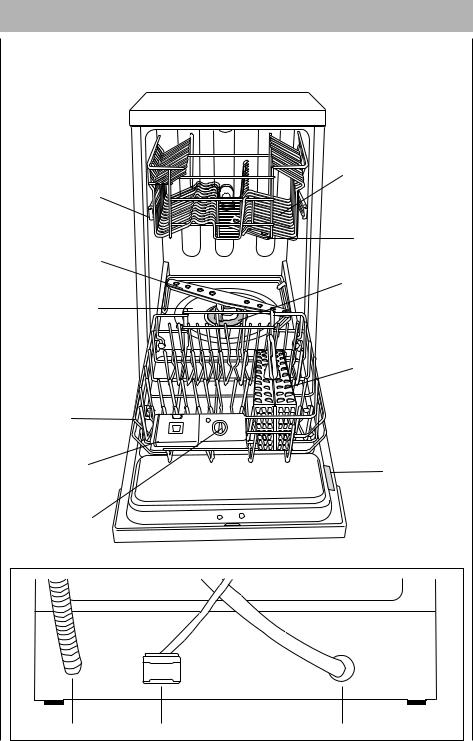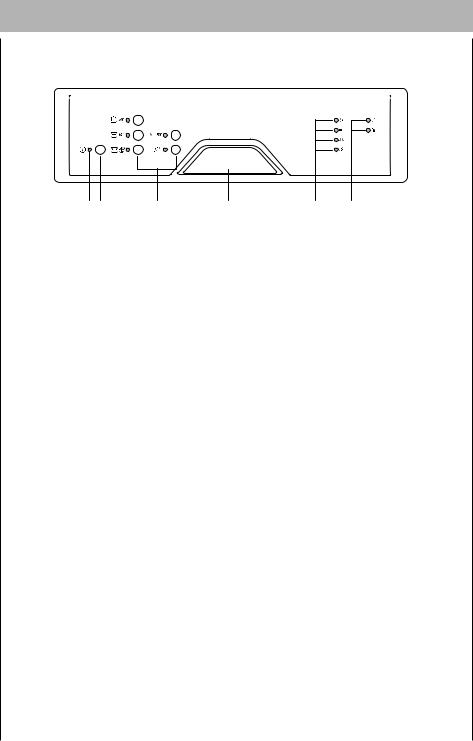AEG-Electrolux F5470I-B, F5470I-W, F5470W User Manual

ÖKO_FAVORIT 5470
Dishwasher
Lavavajillas
Operating instructions Instrucciones de uso

Contents
Safety instructions |
3 |
Disposing of packaging and old machine |
5 |
Disposing of the packaging |
5 |
Disposing of your old machine |
6 |
Important hints |
7 |
Operating your dishwasher economically and with regard |
|
for the environment |
7 |
Unsuitable crockery |
7 |
Suitable crockery |
8 |
Description of the appliance |
9 |
The inside of the appliance |
9 |
Use |
10 |
Control panel |
10 |
Washing programmes |
12 |
Before using your dishwasher for the first time |
14 |
Setting the water hardness range |
14 |
Filling with special salt |
16 |
The rinse aid |
17 |
Setting the rinse aid quantity to be added |
18 |
Adding dishwashing detergent |
18 |
BIO programmes and compact powders |
20 |
Loading your machine |
21 |
The lower basket |
21 |
Cutlery basket |
22 |
The upper basket |
24 |
Adjustment the height of the upper basket |
25 |
Operating instructions |
26 |
Care instructions |
28 |
Internal and external cleaning |
28 |
Cleaning the central filter |
28 |
Cleaning the large filter |
29 |
Servicing |
30 |
Customer service |
33 |
Technical data |
34 |
Installing |
35 |
Connecting the water supply |
38 |
Water outlet connection |
39 |
Water protection system |
40 |
Electrical connection |
40 |
2

Safety instructions
The safety of AEG electrical appliances conforms to accepted rules of technology and the Appliance Safety Act. We as manufacturers, however, see ourselves as being obliged to familiarise you with the following safety instructions.
Using your dishwasher for its intended purpose
●Only use your dishwasher for machine washing of household crockery. If your machine is misused or used for any purposes other than that
for which it is intended, the manufacturer cannot be held liable for any damage caused.
●For safety reasons, you should not convert or modify your dishwasher in any way.
Before using your dishwasher for the first time
●Check your dishwasher for any transport damage. Never connect a damaged machine. If your dishwasher is damaged, you should contact your supplier.
●Your dishwasher must be correctly installed and connected. Please read the section on "Installation" to make sure you know all about this.
●Before using your dishwasher for the first time, do not forget that the nominal voltage and current type indicated on the rating plate of your machine must be the same as the nominal voltage and current type at the installation site. The necessary electrical fusing is also given on the rating plate.
Child safety
●Packaging parts (e.g. foils, styrene foam) may be dangerous for children,who could even be suffocated! You should therefore keep all packaging well away from children.
●Children may not recognise the dangers of improper use of electrical appliances. You should therefore ensure proper supervision during operation and not allow your children to play with your dishwasher.
●Detergents may have a caustic effect on eyes, mouth and throat and may even cause suffocation! Keep all detergents in a safe place out of children’s reach.
3

●The water in your dishwasher should not be used for drinking. Detergent residues may still be present in your machine. Make sure you do not splash these caustic residues onto your skin or suffocate yourself! Keep children well away from your dishwasher when its door is open.
Your dishwasher in day-to-day use
●Never operate your dishwasher if the electrical supply lead, supply or drainhose, control panel, worktop or plinth are damaged.
●If there is a fault, first turn the water tap off. Then switch off your machine and pull the plug out of the socket. If there is a fixed connection, switch off or unscrew the fuse(s).
●Never pull the plug out of the socket by the cable - always hold the plug.
●Dishwasher repairs should only be performed by trained personnel. Improper repairs may seriously endanger the user. If your dishwasher needs to be repaired, you should contact our service centre or your retailer.
●Never place any solvents in your dishwasher or you may cause an explosion!
●Do not rest or sit on the open door or the machine could tilt.
●Before using special dishwasher salt, detergent or rinse-aid, make sure that the manufacturer of these products expressly specifies their use in domestic dishwashers.
●Always turn off the water tap when your dishwasher is left unattended for any length of time, e.g. when you are away on holiday.
●Only transport the dishwasher in an upright position. Tipping it upside down during transport could cause salty water to leak into the internal compartment and lead to the formation of rust.
4

Disposing of packaging and old machine
Disposing of the packaging
Our dishwashers require effective protective packaging in transit, though we always confine ourselves to what is absolutely necessary.
Warning! Packaging parts (e.g. foils, styrene foam) may be dangerous for children, who could even be suffocated! You should therefore keep all packaging well away from children.
All packaging materials used are environmentally compatible and reusable.
The cardboard parts are produced from recycled paper, and the wood is untreated.
The plastics are marked as follows:
>PE< |
for polyethylene, e.g. packaging foils. |
>PS< |
for polystyrene, e.g. padding (essentially CFC-Free). |
>POM< |
for polyoxymethylene, e.g. plastic clamps. |
Give the packaging for reuse to your local recycling centre. Your municipal or local authority will give you its address.
5

Disposing of your old machine
When your machine finally reaches the end of its life and you withdraw it from service, you should render it unserviceable before having it disposed of.
Warning! Children at play could lock themselves in your machine (and suffocate) or otherwise endanger their lives. Therefore pull out the main plug and detach and discard the electrical supply lead.
Disable the door lock so that the door no longer closes.
Marking of plastic parts for graded recycling: all plastic parts in your machine are marked with internationally standardised abbreviations (e.g. <PS> for polystyrene). When your machine is disposed of, this enables plastic waste to be sorted into individual types for environmentally conscious recycling.
Take your decommissioned machine to your local recycling centre or dealer, who will take it back from you for a small handling charge.
6

Important hints
Operating your dishwasher economically and with regard for the environment
Collect your dirty dishes, stack them in the dishwasher, and only wash them when both baskets are full, making sure that the latter are never overloaded. Only then can you be sure that you are machine-washing economically and with regard for the environment.
Always select the programme corresponding to the type of crockery and degree of soiling (see "Washing programmes" chart).
Never overdose detergents, special salt or rinse-aid. Follow the dosage recommendations in these operating instructions as well as the instructions given by manufacturers of these products.
Make sure that the water softener is correctly set.
Unsuitable crockery
The following are unsuitable for machine washing:
-wooden boards or platters
-non-heat-resistant plastic parts
-lead crystal glass
-tin or copper items
-glued crockery or cutlery
-older types of cutlery with temperature-sensitive adhesive
-steel knives that are liable to rust
-cutlery with wood, horn, porcelain or mother-of-pearl handles.
7

Suitable crockery
The following items have certain machine washing limitations:
-Only wash earthenware crockery in your dishwasher if the manufacturer has expressly indicated it as being suitable for that purpose.
-Some types of decoration which have been painted over the glaze may fade after frequent machine washing.
-Silver and aluminium parts tend to discolour during machine washing.
-Many food residues, such as egg white, egg yolk and mustard often cause discolouration or staining on silver. Silver crockery and cutlery should therefore always be cleaned of food residues if they are not washed immediately after a meal.
-Some types of glass may become cloudy after many washing cycles. You should therefore continue to hand-wash especially valuable glassware.
When buying new crockery and cutlery, confirm that they are dishwashersafe.
8

Description of the appliance
The inside of the appliance
Upper basket
Upper basket stop
Upper spray
arm
Lower spray arm
Central filter
Large filter
Salt container 


|
Cutlery basket |
Lower |
|
basket |
|
Detergent |
|
dispenser |
Rating plate |
Rinse aid |
|
|
|
dispenser |
|
|
|
Drain hose |
Supply cable |
Inlet hose |
9 |
|
|
|

Use
Control panel
12 |
3 |
4 |
5 |
6 |
1. Pilot light
This comes on when the on/off button is depressed, indicating that the machine is on.
2. On/off pushbutton
On
Press this button to preset the dishwasher to accept the setting of the wash programme.
Off
When the washing programme has finished, the machine stops automatically.
To switch the machine off at the end of the programme or to stop it if required at any time during operation, press the on/off pushbutton.
3. Programme selector pushbuttons
To select a programme, press the button corresponding to the programme you wish to select. Follow the instructions in the chart "Washing programmes".
4. Door handle
To open the door press the catch in the top of the recess and pull the door towards you at the same time.
10

5. Programme sequence indicator
As soon as you select a washing programme, this illuminates all the phases the programme consists of.
You are able to see during the cycle which phase the dishwasher has reached as the light of the phase under way will illuminate.
Prewash / Rinse and hold
Wash
Rinse
Hot air drying
At the end of the cycle all lights will turn off.
6. Control lights
 - salt control
- salt control
Flashes when the salt container needs refilling.


 - Rinse aid control
- Rinse aid control
Flashes when the rinse aid dispenser needs refilling.
11

Washing programmes
Programmes |
Quantity of food scraps |
Type |
Required |
|
|
|
Type of soil |
of load |
pushbuttons |
|
|
|
|
|
|
|
|
INTENSIVE |
Heavy soiled, also dried up and |
|
|
|
|
containing starch (i.e. pasta, rice, |
Pots and |
on |
70° |
||
70°C |
semolina, potatoes, egg, sauces, |
||||
roast). |
various |
off |
|
||
|
|
different |
|
|
|
|
|
kinds of |
|
|
|
|
Normally to heavily soiled, also |
|
|
||
NORMAL |
crockery |
on |
|
||
dried up and/or containing starch |
|
||||
65°C |
(i.e. pasta, rice, semolina, |
and cutlery |
off |
65° |
|
potatoes, egg, sauces, roast). |
|
|
|||
|
|
|
|
||
|
|
|
|
|
|
NORMAL |
Normally to lightly soiled not dried |
Crockery |
on |
|
|
up and starchless (i.e. no burnt-on |
and |
BIO |
|||
BIO 50°C |
|||||
meat residues, boiled or raw |
cutlery |
off |
50° |
||
|
vegetables, milk, coffee, drinks). |
|
|
|
|
|
|
|
|
|
|
* Quick |
Lightly soiled, not dried up and |
Crockery, |
on |
|
|
cutlery |
|
||||
50°C |
starchless (i.e. drinks, cakes and |
50° |
|||
pastry, salad, sliced ham, cheese). |
Party |
off |
|||
|
|
||||
|
|
Crockery |
|
|
|
|
|
|
|
|
|
RINSE |
Partial load to be completed later |
|
on |
|
|
in the day. |
|
|
|||
AND HOLD |
This programme does not require |
|
off |
|
|
|
detergent. |
|
|
|
|
|
|
|
|
|
Testing programme according to IEC 436/DIN 44990:
-Standard place setting: 9.
-Rinse aid selector on position 3.
-NORMAL 65°C programme with standard detergent type A;
-Recommended quantity of detergent: 15 g in the dispenser
10 g on the dispenser lid.
-NORMAL BIO 50°C programme with standard detergent type B;
-Recommended quantity of detergent: 20 g in the dispenser
5 g on the dispenser lid.
*This is a special programme for quick washing (approx. 35 minutes) a full load of lightly soiled dishes, glasses and crockery (except pots) so that you may re-use them promptly. Due to the shortness of this programme, no drying phase is provided.
12
|
|
|
|
|
|
|
|
|
|
|
|
|
|
|
|
Recommended quantity |
|
|
Approximate values *** |
|
|
||
of detergent ** |
|
|
|
|
|||
|
Programme duration |
Energy |
Water |
|
|||
inside |
on the |
Cycle description |
in minutes **** |
|
|||
consumption |
|
||||||
the |
dispenser |
|
1 |
2 |
consumption |
|
|
dispenser |
lid |
|
kWh |
in litres |
|
||
|
|
|
|
|
|
|
|
|
|
Prewash up to 50°C |
|
|
|
|
|
20 g |
10 g |
Main wash up to 70°C |
85 |
75 |
1,4 |
18 |
|
2 cold rinses |
|
||||||
|
|
1 hot rinse up to 65°C |
|
|
|
|
|
|
|
Hot air drying |
|
|
|
|
|
|
|
|
|
|
|
|
|
|
|
Prewash up to 50°C |
|
|
|
|
|
15 g |
10 g |
Main wash up to 65°C |
75 |
70 |
1,0 |
15 |
|
2 cold rinses |
|
||||||
|
|
1 hot rinse up to 65°C |
|
|
|
|
|
|
|
Hot air drying |
|
|
|
|
|
|
|
|
|
|
|
|
|
|
|
Cold prewash |
|
|
|
|
|
|
|
Main wash up to 50°C |
|
|
|
|
|
20 g |
5 g |
2 cold rinses |
80 |
70 |
0,9 |
14 |
|
|
|
1 hot rinse up to 65°C |
|
|
|
|
|
|
|
Hot air drying |
|
|
|
|
|
|
|
Main wash up to 50°C |
|
|
|
|
|
20 g |
/ |
1 cold rinse |
40 |
35 |
0,7 |
11 |
|
|
|
1 hot rinse up to 60°C |
|
|
|
|
|
|
|
|
|
|
|
|
|
|
|
1 cold rinse |
10 |
|
0,1 |
4 |
|
/ |
/ |
(to avoid food scraps from |
10 |
|
|||
sticking to the dishes). |
|
|
|
|
|
||
|
|
|
|
|
|
|
|
|
|
|
|
|
|
|
|
**As some products can be more efficient than others, please also pay attention to the dosage instructions from the manufacturer of your brand. I f you use the modern "compact" powders containing enzymes, we recommend as a fundamental rule that you select the 50°C programme as the enzymes function at their most effectiveness at around this temperature.
***These specifications are indicative values and depend on the pressure and temperature of the water, and also on voltage modifications.
****The duration of the programme depends on the total power absorbed. This value can be found on the rating plate on the right hand side of the door. In this way you will easily discover the column of the programme duration relating to your appliance.
Column 1= 230V / 2250W / 10A
Column 2= 230V / 2950W / 16A 220-240V / 2770W / 13A
13
